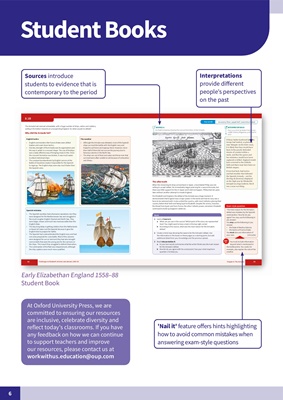
6 Student book
This thoroughly updated second edition is a student-friendly and
truly supportive resource, including new graphs and maps, and
updated geographical data. It motivates students with accessible,
topical content and case studies while retaining a rigorous approach.
20 212121
20 Section A - The Challenge of natural hazards
Unit 1 - Living with the physical environment
Tectonic hazards
On this spread you will find out about responses to earthquakes
in two areas with contrasting levels of wealth
Responses to earthquakes
2.5 Responding to earthquakes
There are two di erent types of response to natural disasters such as earthquakes:
● Immediate (short-term) responses - these initially focus on search and rescue and providing
emergency resources such as water, food, medicine, shelter and safety.
● Long-term responses - these involve re-building and reconstruction, returning society to 'normal'
and reducing future risk.
Comparing responses in Japan and Nepal
Earthquakes and associated tsunami ('tsunami' is a Japanese term meaning 'harbour wave') are
common in Japan. On 1 September each year the entire country takes part in an earthquake drill.
Scientific monitoring and warning systems give a few seconds' notice of ground shaking and, in 2011,
local communities had 15 minutes' warning of the approaching tsunami waves.
As in Japan, earthquakes are common in Nepal. Scientists have identified a pattern of particularly
large earthquakes occurring every 80 years or so. Despite these warnings and new building
regulations, not enough had been done to prepare the city of Kathmandu before the 2014 earthquake.
Japan: immediate responses
• Search and rescue teams from Japan and
abroad, with 100000 members of the
Japanese Self-Defence Force, worked for
several days, yet there were few survivors.
• 500000 people were evacuated to higher
ground before the tsunami struck. Many
had their homes destroyed and needed
emergency shelter, food and water.
• Within a few weeks some roads and railway
networks had been restored, improving
access to the region.
• Power was soon restored but supply was
intermittent due to the explosions at the
Fukushima nuclear power plant caused by
the tsunami.
Japan: long-term responses
• The Reconstruction Design Council devised a long-term
plan (2012-2022) for the region, identifying zones for
reconstruction with simpler planning procedures. Tax
incentives promoted investment in industry and
business. A reconstruction budget of over US$150 billion
was created.
• By early 2015 most debris had been cleared and new
housing constructed away from low-lying coastal areas.
• By 2020 nearly 30000 units of public housing had been
completed, replacing almost all of the temporary
homes. Industrial production had returned to predisaster levels and almost all farmland and seafood
processing plants had been restored.
• In 2013 an upgraded tsunami warning system was
launched, providing faster and more accurate forecasts.
Sea walls (up to 12.5m high) and embankments have
been constructed to protect cities, industries and power
plants.
A Temporary housing units at Otsuchicho for those made
homeless by the earthquake and tsunami
B Construction of a
tsunami sea wall
barrier to protect
the fishing port of
Kesennuma
Nepal: immediate responses
• International search and rescue teams, including
the British organisation Search and Rescue
Assistance in Disasters (SARAID) (photo C) rescued
16 survivors. Water and medical support arrived
from the UK, China and India.
• An estimated 1.4 million people urgently needed
water, food and shelter. World Vision International
provided emergency food kits for 8000 people and
shelter materials for 20 000 families.
• Helicopters rescued many people caught in
avalanches on Mount Everest and delivered
supplies to villages cut o by landslides.
• Field hospitals were set up by organisations such
as the Red Cross. More than half a million tents were erected.
• Around 300 000 people migrated from Kathmandu to seek shelter and support from family and friends.
Rubble to
be shi£ ed
Video cameras to see
inside collapsed buildings
L i £ i n g
equipment
Rescue dogs Listening for
survivors
Local knowledge
Weak buildings -
danger of collapse
C Searching for survivors in Kathmandu
Nepal: long-term responses
• In 2018 Nepal adopted a new National Disaster Risk Reduction
Policy to increase future resilience.
• By the end of 2015 most access roads had been repaired and
landslides cleared. Trekking routes on Mount Everest were
restored and tourists (an important source of income) returned.
• The Nepal Earthquake Housing Reconstruction Project,
supported by US$700 million from the International
Development Association (IDA), provides grants to help people
rebuild their homes using disaster-resilient construction
techniques and materials (photo D). By September 2020, 212000
new homes (of the planned 335700) had been constructed.
• UNESCO is working with the government to restore 700 damaged temples, palaces and museums.
Activities
1 Look at photo C.
a Suggest how search and rescue
teams locate and rescue people
from collapsed buildings.
b Why were so few people rescued in
Nepal?
2 Suggest why it was important to
restore the infrastructure in both
Japan and Nepal.
3 Contrast the responses to the
destruction of housing in Japan
and Nepal.
4 Suggest three reasons why
reconstruction has been relatively
slow in Nepal.
Practice question
With reference to named examples, to what extent do contrasting levels of
wealth a ect the responses to a tectonic hazard? (9 marks)
Tips
• You should refer in detail to the two earthquake examples, Japan and Nepal.
• Focus on 'to what extent' - in other words consider the importance of wealth
compared to other factors, such as the scale of destruction, infrastructure
and government.
Extension
'Long-term responses should involve local communities in all aspects of
reconstruction.' Examine what is meant by this statement. Conduct additional
research online.
D Reconstructed house designed to resist
future earthquakes
202912_AQA GCSE Geog SB_Ch02.indd 20-21
202912_AQA GCSE Geog SB_Ch02.indd 20-21 05/11/21 11:03 PM
05/11/21 11:03 PM
Draft Student Book
Extension tasks and
practice questions
on every spread help
students succeed
Up-to-date case studies
provide real-world
examples that your
students can relate to